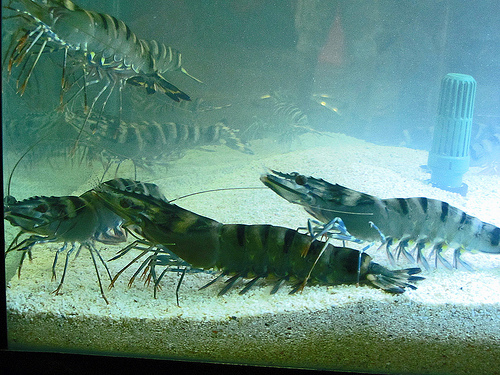Tiger prawn (Penaeus monodon Fabricius) or sugpo culture is one of the most profitable industries in Region 10. It has significant economic contributions to the region as it encourages employment and generates foreign currency.

In the early 1990s, the prawn industry suffered major losses from a luminous bacterial disease called Vibrio. It hit Northern Mindanao, the country’s leading supplier of sugpo. Prawn farms suffered heavy losses, which led to cessation of operations.
To remedy the problem, the prawn industry focused on safe fishpond management and culture techniques. Some of the procedures include the use of antibiotics, disinfectants, probiotics, and nutritional enrichments. In addition, pond cleaning and drying were implemented. These steps showed improved production, although results vary across farms. They proved effective on some farms, while there were no significant change on others. These efforts from the government and the private sector focused on solutions for an intensive shrimp culture system.
A majority of prawn farms in Misamis Occidental, however, practice the extensive culture system, which is characterized by a stocking density of five pieces or less of prawns per square meter. It utilizes naturally occurring food sources and is suitable to the region’s long coastal lines. Extensive farms are also vulnerable to the spread of Vibrio.
Perlito Vallejos and Gigi Albor of the Bureau of the Fisheries and Aquatic Resources in Bonifacio, Misamis Occidental studied the “Greenwater treatment in enhancing the production of Tiger Prawns in Extensive Ponds.” The study aims to accelerate the rehabilitation process of the prawn industry in Region 10 in an environmental-friendly way by integrating tilapia in enhancing growth of microalgae.
The ponds used were stocked with 5 pieces of prawn per square meter with 5,000 tilapia contained in a 10m x 10m net cage.
Using saline-tolerant tilapia increases algal bloom and supplies green water to the pond. The analysis showed that there is consistent algal population compared to ponds without tilapia. Furthermore, the ponds became less susceptible to bacterial attacks and had low luminous bacterial count. The slime of the tilapia contains bacteriostatic components that inhibit the attack of Vibrio.
With the greenwater technique, the average body weight of 30 grams or more are achievable within four months or less of culture. Survival rate is about 50%, as opposed 11% in ponds without tilapia.
The demo farms with tilapia attained a return on investment of as much as 250% while those without the tilapia achieved an ROI of less than 50%.
The greenwater technique is an initial step towards a sustainable prawn industry. Further studies on stocking density, ratio of prawn to tilapia and other issues are still needed.
——————————–
Source:
Greenwater Treatment in Enhancing the Production of Tiger Prawn in Extensive Ponds by Perlito Vallejos and Gigi Albor of DA-BFAR Region 10, Cagayan de Oro City; Tel.No. (052)484-6686; Won the AFMA Outstanding Paper Award 2001, Fisheries and Marine Science Unpublished Category.
By: Junelyn dela Rosa, BAR Chronicle, October 2001 Issue (Vol. 2 No. 19-20)






